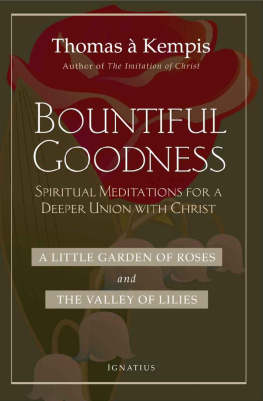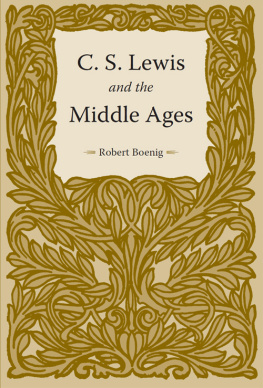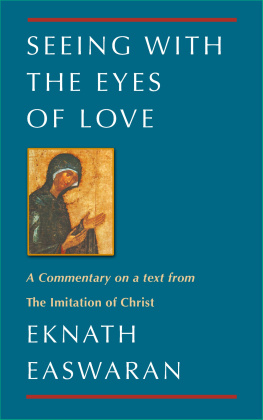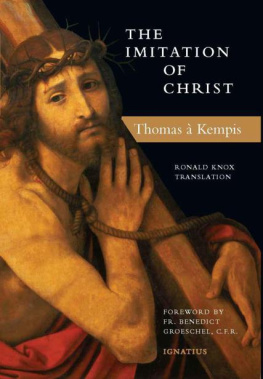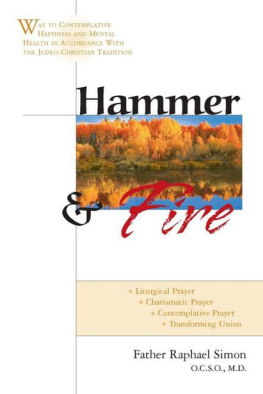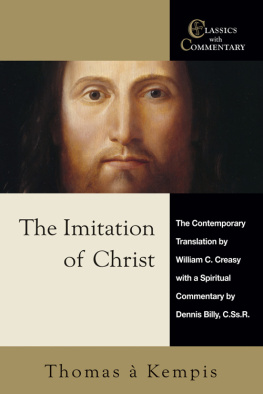BOUNTIFUL GOODNESS
THOMAS KEMPIS
Bountiful
Goodness

A Little Garden of Roses
&
Valley of Lilies
Translated by
JOSEPH N. TYLENDA, S.J.
IGNATIUS PRESS SAN FRANCISCO
Cover design by Riz Boncan Marsella
Cover photograph: istockphoto.com
2013 by Ignatius Press, San Francisco
All rights reserved
ISBN 978-1-58617-778-2
Library of Congress Control Number 2013931024
Printed in the United States of America
Contents
Introduction
The author of both these short treatises, A Little Garden of Roses and The Valley of Lilies , is Thomas Kempis, who is likewise the author of The Imitation of Christ , the most famous and most beloved Christian devotional book ever written. Though these treatises have not enjoyed the popularity of the Imitation , nevertheless, they stand immediately at its side by reason of their spiritual teaching. The simplicity and piety that the reader has already come to know in the Imitation will also be found in these. In content and style, the treatises and the Imitation are very similar, for the aim of all of Thomas work is to draw the reader to a closer union with the Lord Jesus. Though similar, they are at the same time different; while the Imitation sets forth the basic principles of the spiritual life, these treatises have a more practical aim, that is, they treat of the virtues that one must live in order to advance in the spiritual life and that are necessary for salvation. The authors main intent here, then, is to offer the reader wise counsel and practical hints toward holiness. Much of what he says is expressed so succinctly that the text often takes on the form of a maxim.
From Thomas pen came some three dozen devotional works, the more important ones among them, in addition to our two, are: The Soliloquy of the Soul , the authors personal colloquies with the Lord and counsels for leading the soul to grace; On the Three Tabernacles , considerations on poverty, humility, and patience; Prayers and Meditations on the Life of Christ , reflections on our Lords public life, Passion, Resurrection, and Ascension; The Elevation of the Mind ; On Solitude and Silence ; and Sermons to Novices .
The Author
Thomas Kempis was born in Germany in the small town of Kempen, near Dsseldorf, north of Cologne, toward the end of 1379 or in the early part of 1380. The family name was Hemerken; his father, John, was a blacksmith, and his mother, Gertrude, the towns schoolmistress. Hence, it was under his mothers tutelage that Thomas had his first years of schooling. In 1392, when he was entering his teens and ready for further studies, Thomas was sent to Deventer, in the Low Countries, to be trained under the Brethren of the Common Life. In going there, Thomas was following in the footsteps of his older brother, John (13651432), who had gone to study with the Brethren some twelve years previously.
At the time of Thomas arrival in Deventer, brother John was no longer there; he had some years earlier joined the Brethren of the Common Life and since 1390 had been a canon at their Windesheim monastery, about twenty miles north of Deventer. So it was to Windesheim that Thomas went to meet his brother. On leaving him, Thomas carried with him his brothers letter of recommendation to Florentius Radewyns (ca. 13501400), Master of the Brethren in Deventer.
Master Radewyns had been one of the first disciples of Master Geert Groote (13401384), founder of the Brethren and of the religious movement known as Devotio Moderna (New Devotion). Because the spiritual life of the fourteenth-century faithful in the Low Countries was on the wane, with the people growing slovenly in the practice of their Catholic faith, Master Groote intended, by his preaching, to renew in the hearts of his hearers the faith that the Dutch had formerly had. This renewal movement came to be known as Devotio Moderna , though there was nothing new or novel about it. It was basically a vibrant revitalization of the faith, and so successful was this movement, involving both laity and clergy, that its followers, known as Brethren of the Common Life, soon began to operate schools that in time became the best in the Netherlands. The one in Deventer was their flagship. After Master Grootes death in 1384, Radewyns succeeded him as head of the movement and superior of the Deventer Brethren. The brothers letter thus placed Thomas under Master Radewyns direct supervision.
Thomas spent the next seven years with the Brethren in Deventer, studying the usual subjects in which any educated person of that period was expected to be proficient, such as Latin and Greek, mathematics, history, philosophy, and religion. Inasmuch as Thomas, a resident student, lived under the close supervision of the Brethren, he likewise received a firm foundation in the Catholic faith, was introduced to the writings of the Fathers of the Church, and participated in many of the Brethrens religious devotions and practices.
When Thomas completed his Deventer studies in 1399, he went, following Master Radewyns suggestion, to visit his brother, who since early 1399 had been prior of the newly founded monastery of Canons Regular of Saint Augustine at Mount Saint Agnes, near Zwolle. In view of Thomas past seven-year association with the Brethren and his familiarity with their manner of life and spirituality, it was perhaps expected that Thomas would request admission into his brothers religious community. This Thomas did, and in the summer of that year, 1399, he was accepted as a candidate. Following monastic custom, he who had been known up to this time as Thomas of Kempen was now to be known, according to Latin usage, as Thomas Kempis. As a candidate, Thomas followed the daily order of the canons, shared their hours of prayer and work, and perfected his calligraphic skill in copying liturgical and devotional books needed for use at Mount Saint Agnes. Printing with movable type would only be invented by Johannes Gutenberg (ca. 13981468) some fifty years later.
On June 10, 1406, which was the Feast of Corpus Christi, Thomas was invested, by his brother, community prior, with the white habit of the Canons Regular of Saint Augustine, the definitive sign of his formal acceptance into the Windesheim Congregation. Then in 1408, he pronounced his religious vows and began his study of theology, which culminated with priestly ordination in 1414. Thomas was then thirty-four years old. He twice served as the communitys subprior; he was first elected to this office in 1425 and again in 1448. As subprior, he not only served as assistant to the prior, the communitys superior, but also fulfilled the important position of master of novices. It is most likely that it was during his first term as subprior that Thomas wrote the treatises that make up The Imitation of Christ .
Except for the few years of his living in a Friesland monastery (14291431) and caring (June 1431November 1432) for his ailing brother, John, then superior of the House of Bethany, near Arnheim, Thomas entire religious life was spent at Mount Saint Agnes. On his return to his monastery that November, after his brothers death, he served as community procurator and in 1448, as mentioned, was again elected subprior.
When not fulfilling administrative positions for the community, Thomas was principally involved in copying books or manuscripts. His skill in calligraphy was such that he was chosen to copy the entire Bible for the communitys use. This task took him fourteen years to complete (14251439); that Bibles five volumes are today preserved in the Darmstadt Library. From Thomas pen, in addition to the spiritual and ascetical books mentioned earlier, there also came three biographies: namely, those of Masters Geert Groote and Florentius Radewyns and that of Saint Lydwine (13801433), a contemporary of his. In writing that of Master Groote, Thomas received his information from those who had known and lived with him, but when it came to writing about Master Radewyns, Thomas wrote about one whom he knew personally. At the time of Thomas death, he was writing his Chronicles of the Canons Regular of Mount Saint Agnes , a history of the monastery from the year of its foundation (1399), which was also the year when Thomas entered as a candidate. This chronicle is one of the chief sources for information concerning him.
Next page
